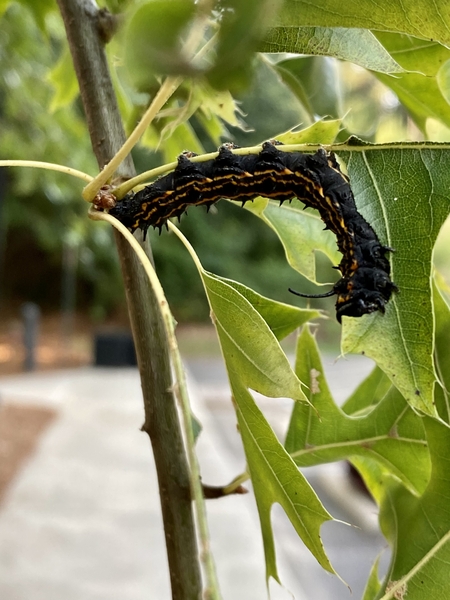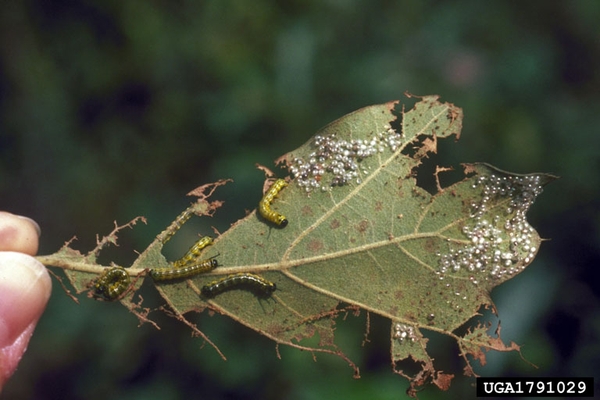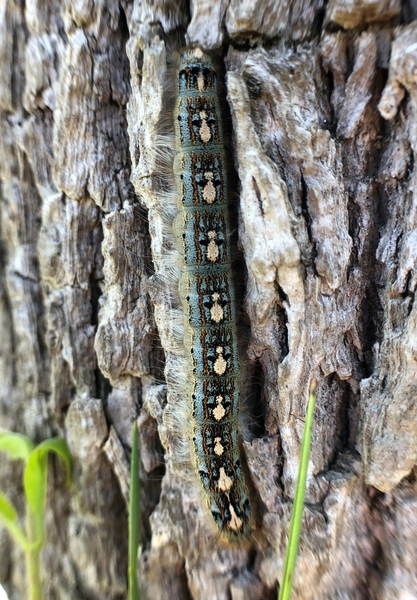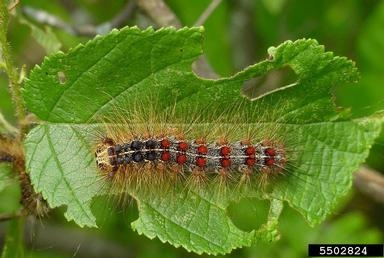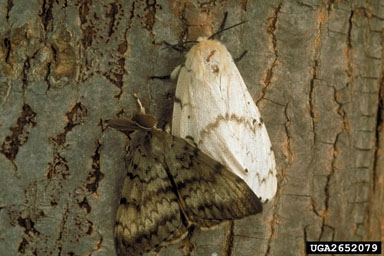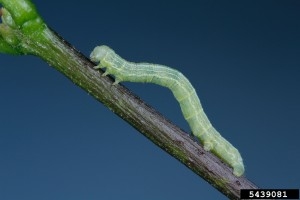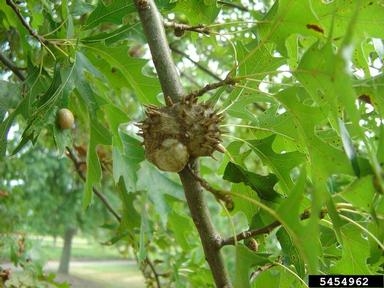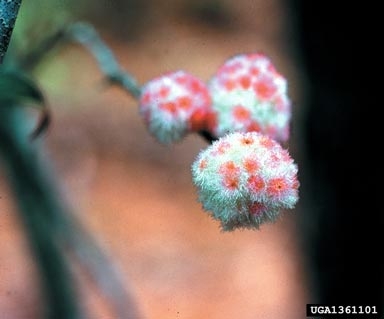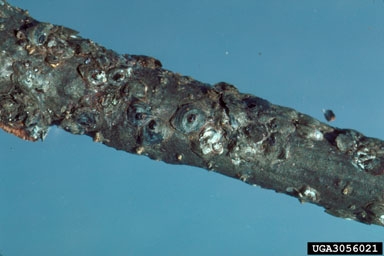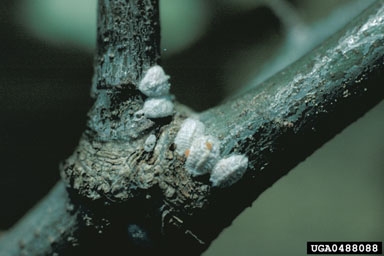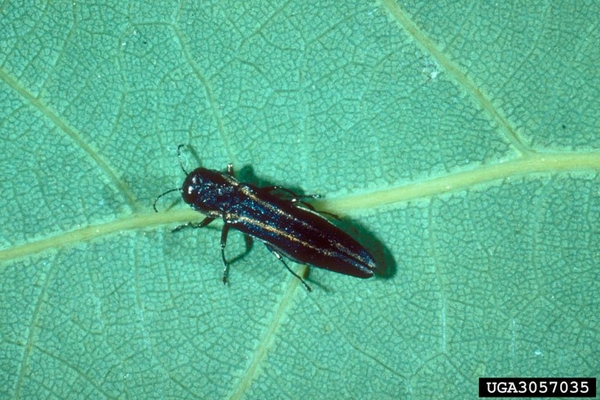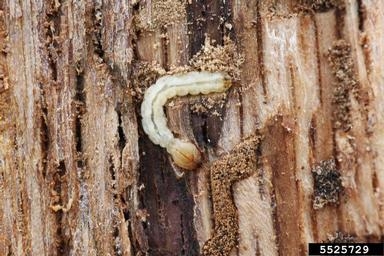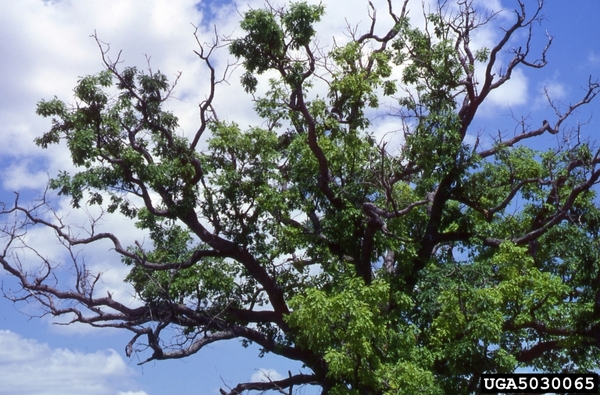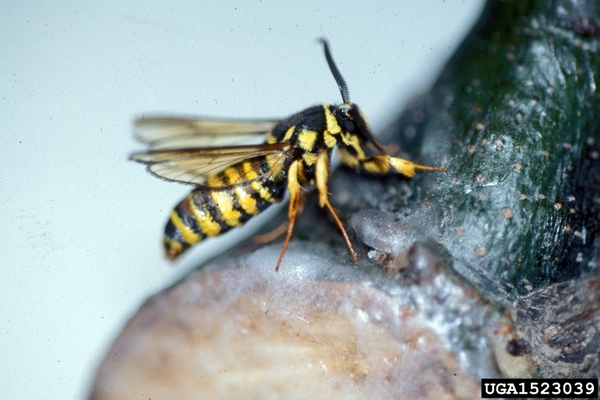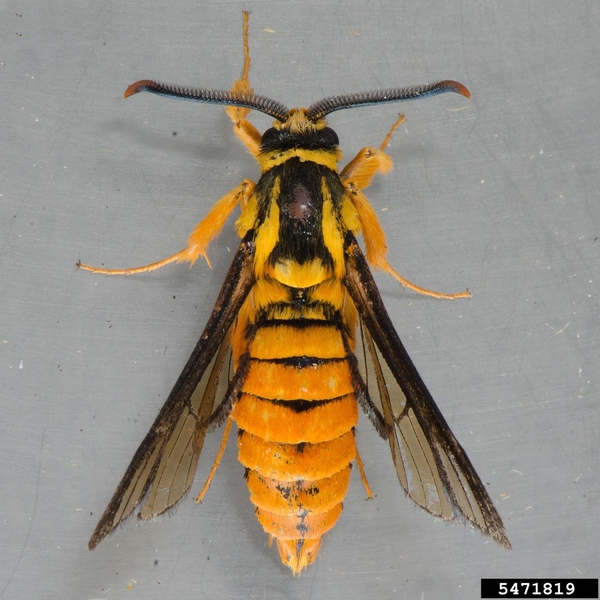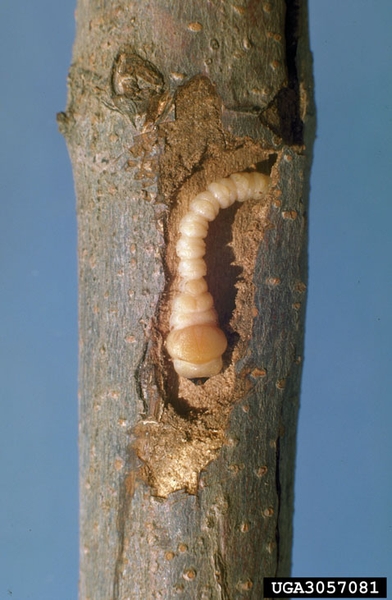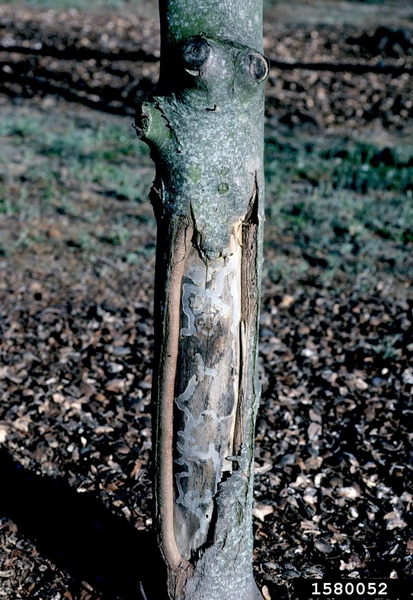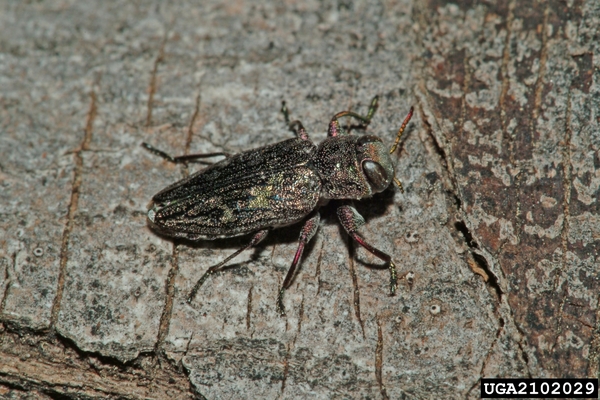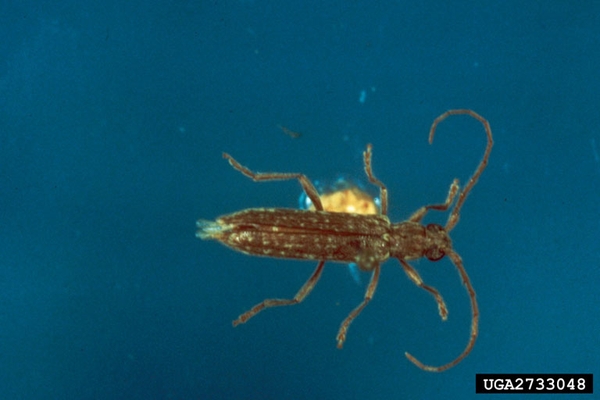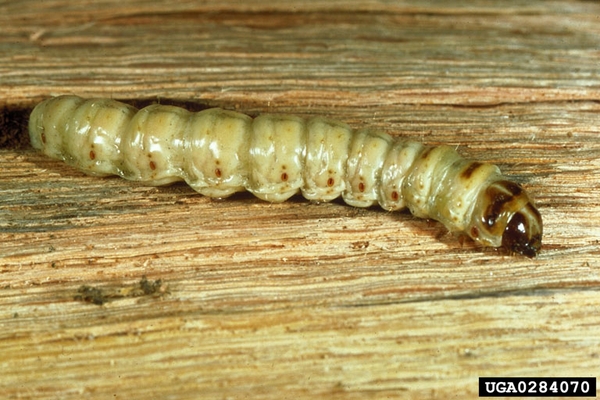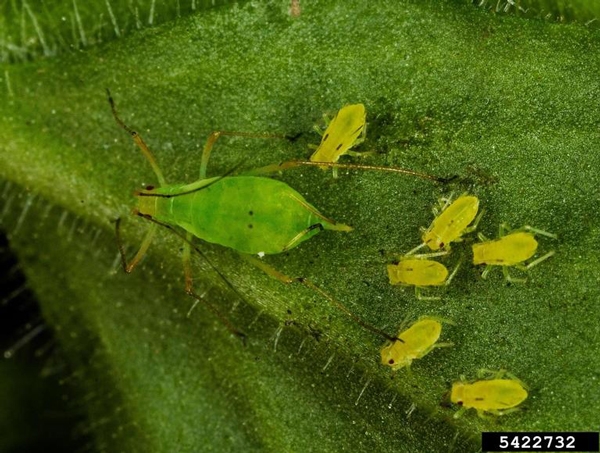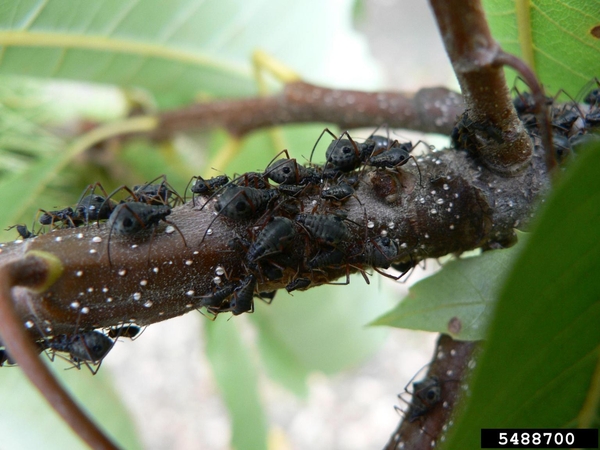FOLIAGE-FEEDING CATERPILLARS
Caterpillars are a common issue for oak trees, as they can defoliate and skeletonize leaves. Defoliation and skeletonization in large amounts can cause stunted growth and moderate dieback without treatment.
Orangestriped oakworm
The orangestriped oakworm (Anisota senatoria) is a common defoliator of urban oak trees across the Southeast. They consume the majority of the leaf tissue, frequently leaving only the midvein. Though they are capable of defoliating an entire tree, they often only affect a few branches. Feeding in clusters, this leads to the appearance of a bare branch amonst a healthy canopy. To identify orangstriped oakworm, look for a black caterpillar with bright orange or yellow stripes running length-wise from the head to the tip of the abdomen. If they have just hatched (around August in Raleigh), they may look somewhat translucent and yellow in color. They are also often noticed due to copious amounts of excrement littering impervious surfaces below. Read more details about orangestriped oakworm management from NC State Extension.
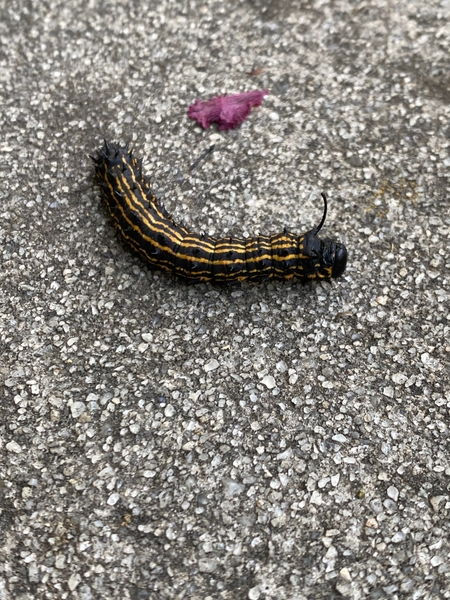
Orangestriped oakworms are black or dark brown with orange or yellow stripes running the length of its body.
Kelly Oten CC BY 4.0
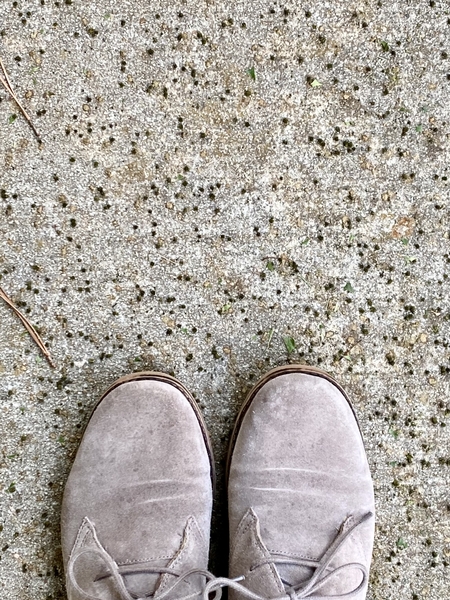
Large amounts of fecal matter dropping below infested branches are often noticed first.
Kelly Oten CC BY 4.0

Orangestriped oakworms consume the soft leaf tissue and leave behind the veins.
Kelly Oten CC BY 4.0
Forest Tent Caterpillar
The forest tent caterpillar (Malacosoma disstria) feeds on a variety of trees in the spring, including oak. Multiple years of defoliation by this insect can cause dieback and stunted growth. Newly-hatched caterpillars have small hairs and are almost entirely black. As they grow older, they become more brown in color and develop white keyhole-shaped spots down the back surrounded by a yellow-brown and blue lines. Despite their name, they do not spin a tent, but create silken mats on branches and truncks. They spine large yellow cocoons inside bark openings and folded leaves. These cocoons are pupating sites for the caterpillars, which turn into short-lived brown moths approximately 10 days later. Eggs are laid in brown masses on the edge of twigs. Read more details about the forest tent caterpillar life cycle and management strategies from NC State Extension.
Spongy Moth
The spongy moth (Lymantria dispar) is not considered established in North Carolina, but small infestations occur sporadically and are managed by the North Carolina Department of Agriculture and Consumer Services. Spongy moth is an invasive pest of a variety of trees and plants and affects all types of oaks. Egg masses are laid in clumps of 500 - 1,000 eggs by female moths, which are pale in color with irregular patches and lines on the wings. The caterpillar is quite prominent; it is about 2 inches long with many hairs. Additionally, it has five pairs of blue spots followed by six pairs of red dots on its back. Older caterpillars produce large amounts of green frass (eventually turning red to brown), which can accumulate towards the base of the tree. Unlike webworms or tent caterpillars, the spongy moth does not form webs, although young caterpillars sometimes form long silk strands. Read more details about the spongy moth from NC State Extension. (In 2022, "spongy moth" was adopted to replace the former common name of Lymantria dispar.)
Fall Cankerworm
Fall cankerworms (Alsophila pometaria) are defoliators of a variety of trees, including oak, elm, ash, and maple. The female insects emerge November through January, and are brown to silver in color. They are often referred to as ‘inchworms’ due to a gap between their first six thoracic legs and last four fleshy prolegs that causes them to ‘inch’ along as they crawl. Large infestations of this insect can cause widespread skeletonization of leaves, but is not typically damaging unless the defoliation is repeated over multiple seasons. The insects can also be a nuisance due to falling frass and silk strands from trees. More information about fall cankerworms can be found from NC State Extension.
GALLS AND WASPS
Galls are abnormal swelling or growths made of plant growth, and are caused by insects, fungi, nematodes, and other organisms. They infrequently affect plant growth and health, but can may sometimes be treated. Wasp galls are either caused by egg production of adult wasps or salivary secretions of grubs.
Horned Oak Galls
Horned oak galls (caused by Callirhytis cornigera and Callirhytis quercuspuncata) primarily affect pin, black, and water oak trees. Two different galls (twig and leaf) are formed by this insect, depending on the generation. The galls are formed by a small, brown wasp. The wasps develop in twig galls, which are brown-orange and develop ‘horns’ right before a new generation emerges. Adult wasps will emerge from these galls and lay eggs within the oak buds. Secretions from the newly-hatched wasp grubs will cause new galls to form on the oak leaves. The grubs are maggot-like, translucent insects, although they may look brown in appearance once older. More information about the horned gall wasp and gall wasps in general can be found from NC State Extension.
Wool Sower Gall
Wool sower galls (Callyrhytis seminator) primarily affect the white oak group, including white oak, chestnut oak, and swamp white oak. Two different galls (twig and leaf) are formed by this insect, depending on the generation. The twig gall carries one generation’s grubs, which are colorless, maggot-like insects. Each grub is developed from seed-like structures inside the gall, which is why this gall is sometimes referred to as the oak seed gall. Another generation’s grubs are enclosed in a leaf gall, which looks quite different from the twig gall. More information about wool sower gall wasps and gall wasps in general can be found from NC State Extension.
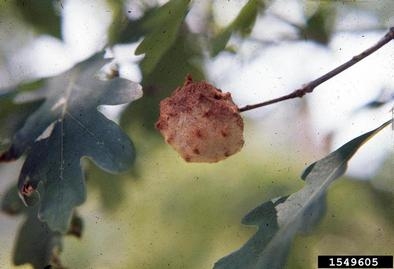
A mature wool sower gall looks distinct both in texture and coloration.
Jim Baker, North Carolina State University, Bugwood.org CC BY 4.0
Oak Apple Galls
Oak apple galls (Amphibolips confluenta) primarily affect scarlet, red, and black oaks. The “apple” in the name comes from the gall’s appearance, which is spongy and reminiscent of apple flesh. The gall is approximately 2 inches long and green with purplish bumps. Once the single wasp emerges from the gall, it becomes brown and dry. More information about oak apple galls can be found from Ohio State University.
SCALE INSECTS
Scale insects are small and have a shield-like or waxy covering made. This covering may resemble a dome, oyster, or a fluffy coat. They feed by sucking plant sap, and often produce honeydew which can attract stinging insects and facilitate sooty mold growth. Scale insects are incredibly diverse and can cause various levels of damage to their host plants.
Oak Lecanium Scale
Oak lecanium scale (Parthenolecanium quercifex) is found on a variety of oak species, as well as birch and hickory. These scales are significant pests of urban oak trees. The adult females are reddish brown, roughly 2-6mm in diameter, and stay attached to their host plant. Adult males are brown and winged. The first life stage of scale insects (known as crawlers) search for a suitable site to settle, inserting their mouthparts and remaining sessile for much of their life. Scale insects suck plant sap and excrete honeydew. In turn, the honeydew attracts fungi known as sooty mold, which can cause the plant stem to become sticky. Large scale infestations of oak lecanium scale can cause a variety of problems, including stunted growth, leaf drop, leaf yellowing, and weakening a tree. More information about lecanium scale can be found from NC State Extension.
Obscure Scale
Obscure scale (Melanaspis obscura) is a common pest of oak, dogwood, beech, hickory, maple, and willow. Typically, this insect is an ornamental and landscape pest; it does not frequently infest naturally-occurring oak trees. The female insect is a yellow to cream color and forms an ‘armor’ that is light gray with a black cap that is off-center. Females mate with males and lay pink eggs over an extended period of time. Feeding damage can result in partial dieback of the tree canopy and premature leaf drop. This pest is especially difficult to treat due to armor covering the insect from insecticides and other treatments. More information about obscure scale can be found from NC State Extension.
Oak Felt Scale
Oak felt scale (Eriococcus querqus) affects willow oak and a variety of other oak species. They are one of the first scale insects to produce eggs in North Carolina. The insect, hence its name, looks like clumps of white felt on twigs and branches. They are often thought to resemble mealybugs and some scale-eating ladybird species, so it is important to exercise caution when treating insects that may resemble oak felt scales. The immature scales produce large amounts of honeydew, whcih is sticky and facilitates the growth of a fungus called sooty mold. Find more information about oak felt scales from NC State Extension.
WOOD-BORING INSECTS
Wood-boring insects can be difficult to detect because part of their life cycle is spent within the tree. Internal feeding can be damaging to the tree, so it's important to detect external signs of wood-borers.
Twolined Chestnut Borer
The twolined chestnut borer (Agrilus bilineatus) affects both red and white oaks and tends to be attracted to stressed and weakened trees in North Carolina. Together with other stress agents, this beetle contributes to a disesase complex called oak decline. Adult twolined chestnut borers are about ⅕ to ½ inches in length and metallic green. They have two yellow stripes on their back. The immature insects are grub-like and have a flattened area right behind their heads. Symptoms include dieback, discolored foliage, and feeding galleries below the outer bark. The best method against this insect is prevention: ensure cultural requirements such as water and soil are adequate for the tree and prevent damage from lawnmowers or other equipment. More information about the twolined chestnut borer is available from NC State Extension.
Red Oak Clearwing Borer
The red oak clearwing borer (Paranthrene simulans) affects both red and white oaks, especially Nuttall, Shumard, cherrybark, and eastern black oaks. The moth prefers to attack the base (or butt) of mature oak trees. These wood-boring moths are yellowjacket mimics, so they are often confused with other insect species. Symptoms of infestation include fecal matter in bark crevices, evidence of pupal cases, and bark swelling. Internally, damage by the moth can cause decay. In North Carolina, the borer tends to only affect the butt of the trunk. More information about the red oak clearwing borer can be found from NC State Extension.
Flatheaded Appletree Borer
The flatheaded appletree borer (Chrysobothris femorata) is a pest of apple, crabapple, dogwood, crapemyrtle, maples, and oak. It widely affects young trees, trees with thin bark, and new plantings. The immature borer is a grub with a head wider than the rest of the body, hence its common name. They bore into the phloem and sapwood, causing girdling in severe infestations. Damage can also deform tree bark. Adult beetles are metallic. More information about the flatheaded appletree borer can be found from NC State Extension.
Twig Pruner
The twig pruner (Elaphidionoides villosus or Anelaphus villosus) often afflicts already-stressed trees and shrubs, including oak, elm, hackberry, locust, maple, sweetgum, redbud, and ornamental fruit trees. In spring, grubs emerge and bore into twigs, chewing tunnels and cuts and migrating along the twig. Eventually, the internal feeding damage causes the branch to fall to the ground, with the grubs inside. Severed twigs are often observed scatted on the ground when hihg populations occur. Examination of these twigs reveals a small, oval-sahped hole, often packed with frass for protective purposes. Larvae pupate within these severed twigs and emerged the following spring. Find more information about the twig pruner from NC State Extension.
Carpenterworm
The carpenterworm (Prionoxystus robiniae) is a moth that affects a variety of shade trees throughout the Southeast. In North Carolina, it favors white oak. The larva (‘worm’) is pink to green and is about 2¼ inches long. As young larvae, they feed in the inner bark before boring deeper into the heartwood of the trees. Though the damage carpenterworms cause doesn’t generally kill the tree, large infestations can cause small trees to break in windy conditions. As adults, the female moth is much larger than the male moth and is dark and mottled. More information about the carpenterworm can be found from NC State Extension.
OTHER PESTS
Aphids are very small insects that appear in clusters, usually on leaf undersides or along stems. They vary in color depending on the species, but a prominent identifying feature is the pair of "tail pipes" (cornicles) at the end of a pear-shaped abdomen. Aphids feed on sap using piercing-sucking mouthparts. Aphids produce copious amounts of a sweet and sticky waste product called honeydew. Honeydew can attract stinging insects and facilitate sooty mold growth, an aesthetically displeasing fungus. In small numbers, aphids do not typically cause damage to the plant. However, large infestations may cause stunted growth, twisted and curled leaves, and sooty mold build up. More information about aphids can be found from NC State Extension.
Publication date: April 5, 2022
N.C. Cooperative Extension prohibits discrimination and harassment regardless of age, color, disability, family and marital status, gender identity, national origin, political beliefs, race, religion, sex (including pregnancy), sexual orientation and veteran status.

